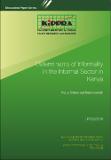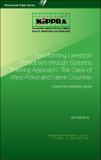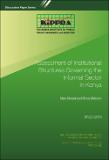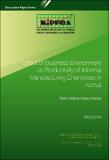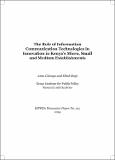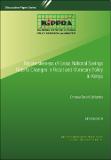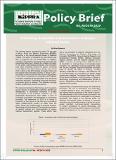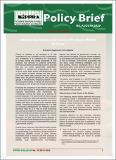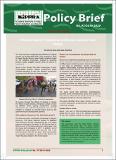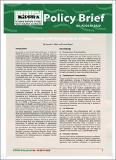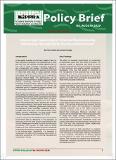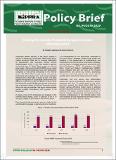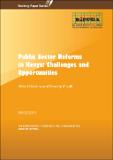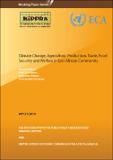3. KIPPRA Research Publications: Recent submissions
Now showing items 281-300 of 708
-
Discussion Paper No. 223 of 2019 on Informal Sector's Response to Shocks: Lessons from Kenya
(The Kenya Institute for Public Policy Research and Analysis (KIPPRA), 2019)The informal sector, often characterized by small scale enterprises, is prone to diverse shocks that pose a threat to their survival. The sector employs most of the people in developing countries such as Kenya. Using World ... -
Discussion Paper No. 217 of 2019 on Governance and Coordination in Management of Drought and Floods Disasters
(The Kenya Institute for Public Policy Research and Analysis (KIPPRA), 2019)Drought and floods are among the most common disasters experienced in Kenya. They cause devastating impacts on human communities, their socioeconomic and environmental support base, with consequences being felt at the ... -
Discussion Paper No. 222 of 2019 on Determinants of Informality in the Informal Sector in Kenya
(The Kenya Institute for Public Policy Research and Analysis (KIPPRA), 2019)The informal sector in Kenya has been persistent, and is critical to employment creation, accounting for 83.4 per cent of new jobs created in 2017. Government policies have failed to address the challenges faced by the ... -
Discussion Paper No. 224 of 2019 on Factors that Determine Choice of Products Market for Businesses in the Informal Sector in Kenya
(The Kenya Institute for Public Policy Research and Analysis (KIPPRA), 2019)Choice of products market by informal businesses is a critical pathway for their survival, performance and profit maximization. Kenya’s informal businesses have an option of selling their products to individual consumers, ... -
Discussion Paper No. 225 of 2019 on Technology Acquisition and Innovations in Kenya's Informal Sector
(The Kenya Institute for Public Policy Research and Analysis (KIPPRA), 2019)Despite Kenya’s high innovation ranking, there are low levels of innovations in her informal sector. The informal sector plays a key role in Kenya’s economy, while technology and innovations both have the potential to spur ... -
Discussion Paper No. 226 of 2019 on Gender Productivity Gap in Kenyan Informal Enterprises
(The Kenya Institute for Public Policy Research and Analysis (KIPPRA), 2019)This study explored gender dynamics in informal establishments in Kenya. The objective was to uncover the underlying factors that cause difference in productivity between men and women-owned establishments in Kenya’s ... -
Discussion Paper No. 219 of 2019 on Transforming Livestock Production Through Systems Thinking Approach: the Case of West Pokot and Narok Counties
(The Kenya Institute for Public Policy Research and Analysis (KIPPRA), 2019)There have been a good number of livestock production studies in Kenya at micro level. However, most of these micro level analyses have not been able to show the feedback between the livestock sector and the rest of the ... -
Discussion Paper No. 227 of 2019 on Assessment of Institutional Structures Governing the Informal Sector in Kenya
(The Kenya Institute for Public Policy Research and Analysis (KIPPRA), 2019)Institutions play a role in determining the economic growth and development of a country. Like many developing countries, Kenya focuses on policy, legal frameworks and development strategies for MSEs due to their ability ... -
Discussion Paper No. 228 of 2019 on Effect of Business Environment on Productivity of Informal Manufacturing Enterprises in Kenya
(The Kenya Institute for Public Policy Research and Analysis (KIPPRA), 2019)A favorable business environment enables easy entry and exit of domestic and multinationals from the markets, lessens the cost of doing business, and hence leads to higher productivity and consequently job creation. This ... -
Discussion paper No. 215 of 2019 on The Role of Information Communication Technologies in Innovation in Kenya’s Micro, Small and Medium Establishments
(The Kenya Institute for Public Policy Research and Analysis (KIPPRA), 2019)The interface between information communication technologies (ICTs) and innovation remains largely under-researched. Attempting to bridge this knowledge gap, this cross-sectional study of Kenya’s micro, small and medium ... -
Discussion Paper No. 206 of 2019 on Responsiveness of Gross National Savings Rate to Change in Fiscal and Monetary Policy in Kenya
(The Kenya Institute for Public Policy Research and Analysis (KIPPRA), 2019)National savings rate is an important indicator of economic health. It indicates the country’s ability to finance a greater share of its development needs using domestic sources. As such, boosting national savings is an ... -
Policy Brief No. 98 of 2019-2020 on Technology Acquisition and Innovations in Kenya's Informal Sector
(The Kenya Institute for Public Policy Research and Analysis, 2019)The informal sector accounts for about 75 per cent of Micro, Small and Medium Enterprises (MSMEs) according to the Kenya National Bureau of Statistics (KNBS). The sector is hampered by slow growth rate, lack of finances ... -
Policy Brief No. 93 of 2019-2020 on Informal Businesses and Choice of Products' Market in Kenya
(The Kenya Institute for Public Policy Research and Analysis (KIPPRA), 2019)This policy brief is based on a KIPPRA study that looks at how informal businesses in Kenya choose a product market and factors that influence such choices. Such information is necessary in unblocking the hindrances ... -
Policy Brief No. 97 of 2019-2020 on Informal Sector's Response to Shocks: Lessons from Kenya
(The Kenya Institute for Public Policy Research and Analysis (KIPPRA), 2019)The informal sector enterprises are affected by diverse shocks that substantially affect their operations. Most of these shocks tend to have drastic negative impact on the affected enterprises, leading to business closure, ... -
Policy Brief No 48 of 2018/2019 on An Assessment of Health care Delivery Under Devolution: County Briefs
(The Kenya Institute for Public Policy Research and Analysis (KIPPRA), 2019)Quality health care is a basic right in Kenya as granted by the 2010 Constitution. It is also a priority government commitment under the “Big Four” agenda on Universal Health Care (UHC) and Vision 2030. Devolution of the ... -
Policy Brief No. 95 of 2019-2020 on Determinants of the Informal Sector in Kenya
(The Kenya Institute for Public Policy Research and Analysis (KIPPRA), 2019)The informal sector in Kenya is characterized by limited job security, low productivity, low incomes, unskilled apprentices, low absorption of technology, poor working conditions, unfair competition to formal establishments, ... -
Policy Brief No. 96 of 2019-2020 on Improving Productivity of Informal Manufacturing Enterprises through Better Business Environment
(The Kenya Institute for Public Policy Research and Analysis (KIPPRA), 2019)A favourable business environment makes it easy for both domestic enterprises and multinationals to enter and exit from the markets, provides opportunities for low cost of doing business, increases productivity and ... -
Policy Brief No. 94 of 2019-2020 on Closing the Gender Productivity Gap in Kenya's Informal Sector
(The Kenya Institute for Public Policy Research and Analysis (KIPPRA), 2019)Advancing gender equality in the labour market is critical to enhancing productivity. Historically, labour market structures have led to unequal distribution of opportunities and resources, leaving women disadvantaged, ... -
Working Paper No. 29 of 2019 on Public Sector Reforms in Kenya: Challenges and Opportunities
(The Kenya Institute for Public Policy Research and Analysis (KIPPRA), 2019)Public sector reforms in Kenya have seen efforts directed towards cost-saving, enhancing efficiency, and improving productivity to ensure people-centered public service delivery. The key cross-cutting issues in the public ... -
Working Paper No. 31 of 2019 on Climate Change, Agricultural Production, Trade, Food Security and Welfare in East African Community
(The Kenya Institute for Public Policy Research and Analysis (KIPPRA), 2019)The East African Region is already experiencing increased climate change impacts including extreme weather conditions, persistent drought, floods, and landslides and rising sea level which threaten food security and efforts ...



